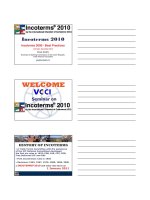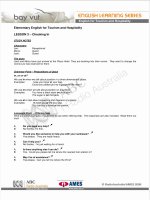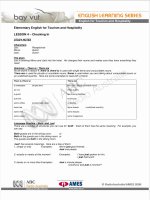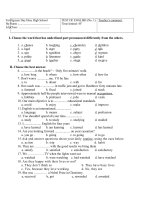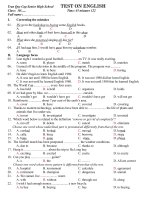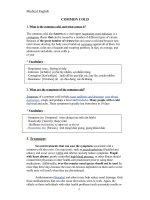English Addressing Forms
Bạn đang xem bản rút gọn của tài liệu. Xem và tải ngay bản đầy đủ của tài liệu tại đây (150.67 KB, 14 trang )
ENGLISH ADDRESSING FORMS
Addressing forms is an interesting phenomenon in the study on cross-
cultural communication. There exist numerous addressing systems in different
cultures and languages. Like many other Eastern languages, Vietnamese
language has a so complicated one that makes foreigners get confused when
using Vietnamese addressing forms. Many foreigners say that accessing to
Vietnamese addressing forms is not much different from entering to a maze. It
is partly true and understandable because Vietnamese addressing system is
one of the most complicated features in Vietnamese language that even its
people find it difficult to use or explain it let alone foreigners who have little
knowledge of the culture of Vietnam. Therefore, this essay will aim at
discovering basic characteristics of the addressing system in Vietnamese
language. This essay will focus on three main parts: the Vietnamese
addressing terms, kinds of addressing relationship and culture shocks that
people often meet when using addressing system.
Firstly, the essay will start off with the Vietnamese addressing terms.
Addressing terms are words used to addressee or call the hearer or speaker in
the communication. It is quite impossible to list in this essay all addressing
terms used in Vietnamese languages. However basically, Vietnamese
addressing terms can be categorized into ten main types. Firstly, like many
other languages, Vietnamese people use basic personal pronouns such as
“tao”, “chúng tôi”, “mày”, “các bạn” ,etc, to addressee each other. This kind
of addressing term are the most commonly used in Vietnamese
communication The next commonly used terms are kinship ones such as
“ông”, “chú”, “cháu”, “con”, etc. Kinship terms are the ones that people
firstly used to call members of ascending generations and then they are
extended to call other members that have no relative relationship in the
society as well. In addition, Vietnamese addressing system also have
addressing terms which are proper name “Lan”, “Mai”,etc; title words such as
“giáo sư”, “giám đốc”, etc; occupational words like “thầy”, “bác sĩ”, etc, or
both title or occupational words plus proper name such as “giáo sư Mai”,
“thầy giáo Hùng”, “trưởng phòng Lan”, etc. More over, Vietnamese people
also use normalizing adjectives to call themselves or the hearer. For example,
an old people can address himself as “già” or “lão”. Such words are originally
adjectives which means “old”, but now are used as personal pronouns. It is
the similar thing applied when people address others by their nicknames such
as “còi”, “béo”, etc. More interestingly, the next addressing term is a very
special one that exist only in Vietnamese addressing form, that is
demonstrative terms such as “đây”, “đằng này”... for the speaker and “đấy”
“đằng ấy”, “ấy” for the hearer. Originally, such words are not personal
pronouns but here they function as personal pronouns effectively. Besides, it
is impossible to forget to list here addressing terms that borrowed from other
countries especially from China and French. This kind of term contributes
dramatically to the diversification of Vietnamese addressing term. They are
words borrowed from China such as “huynh”, “đệ”, “tỷ”, “muội”, “trẫm”, etc
and from French such as “moa”, “toa”, etc. Finally there are also terms of
affection or endearment such as “cưng” “cún con ”, “anh yêu”, etc which are
used most commonly when the addresser and addressee have an very,
intimate relationship.
According to many people both Vietnamese and foreigners, Anglicist
addressing system is much simpler than Vietnamese one. It is because of this
that in Anglicist system, there exists a neutral dyad “I-You” which is used in
communication as “prefabricated units”. “Prefabricated units,” means that
these units can be used in any context and with anyone. It can do so because
“I” and “you” do not include in themselves any information of age, gender or
family relationship, etc. However, unluckily, Vietnamese addressing one has
no equivalence with the dyad “I-You” in Anglicist because there are always a
number of socio-cultural factors dominating Vietnamese addressing system.
The factors that determine languages forms of address terms vary from one
culture to another. However, the prominent determining factors in Vietnamese
forms may be occupational status, age, family hierarchy and interactional
context. The occupational status factor say that people with different social
status will be addresses differently depending on the position that they take in
the society. For example a teacher can be addressed as “thầy giáo” but when
he become a headmaster, he will be called “Thầy hiệu trưởng”, etc. The same
thing can be applied to the factor of age. It is deepened on the gap between
the speaker and the hearer that a person can decide the appropriate addressing
term to call himself and the interlocutor. For example if the speaker is much
older than the hearer, he can address the hearer as “ông” or as “bác”, “chú”,
“anh” if the hearer is less older. Kinship terms are one of the most widely
term used in Vietnamese addressing system and family hierarchy is the
dominant factor in choosing the right addressing term. Family hierarchy is the
order of the relationship between people who share some family connections.
However, it is used to address people that between them there have not any
family ties also but if the relationship between the interlocutors is family
relationship, the addressing term system will be decided by this factors
regardless of another factors such as age or interactional context. Supposing
the speaker is much older than the hearer but the hearer is the younger sister
of the speaker’s mother, therefore the speaker will have to address himself as
“cháu” and call the hearer as “dì”. However this factors will not be apply if
kinship terms are used to address people without family ties, in that case there
will be other factors will affect the decision-making of the interlocutors. The
factor of interactional context also plays a very important role in deciding the
addressing term. It means that the decision of choosing addressing term is
different in different context of communication. The addressing terms used in
trade transactions is different with those used in meeting or at school. For
instance, a son at home can address himself as “con” and call his mother as
“mẹ” but at school, his mother is his teacher also, he has to change the
addressing terms as “em” and call his mother as “cô”. Besides these main
factors, there are still a number of important other ones that affect similarly
the way people addressee as the mentioned factors. They are such factors as:
gender, qualifications, physical strength, occupations, marital status and
dwelling area. Among which, the factor of dwelling area is also an important
and interesting one that affect the way people address. For example, in the
North of Vietnam, people call their parents as “bố” and “mẹ” but in the South,
they call them as “ba” and “má” or people living in northern villages call their
parents as “thầy” and “u”. The choice to use appropriate addressing term
sometime is made easily but sometime very difficulty especially when a
number of socio-cultural factors dominate the choice at the same time. In
order to understand more about how to addressing people, the next part of this
essay will work as a very efficient tool.
As mentioned above, there are many kinds of address forms in
Vietnamese which are dominated by different socio-cultural factors. One of
the most important particular traits of the Vietnamese is that they always
appreciate their families, which also affects the usage of address forms in
daily life. Therefore the most popular address form in Vietnamese is kinship
terms which have been used to address people within the family.
In Vietnamese (Northern dialect), there are usually 34 dyads of kinship
terms which are equivalent to the dyad I – YOU in American English in terms
of 6 generations around “ego”
STT Kinship terms as address forms used in family
First person Second person
1 Cè ChÝt / Con
2 ChÝt / Con Cè
3 Kþ Chót / Con
4 Chót / Con Kþ
5 Cô Ch¾t / Con
6 Ch¾t / Con Cô
7 ¤ng Ch¸u / Con
8 Ch¸u / Con ¤ng
9 Bµ Ch¸u / Con
10 Ch¸u / Con Bµ
11 B¸c Ch¸u / Con
12 Ch¸u / Con B¸c
13 Bè Con
14 Con Bè
15 MÑ Con
16 Con MÑ
17 Chó Ch¸u / Con
18 Ch¸u / Con Chó
19 C« Ch¸u / Con
20 Ch¸u / Con C«
21 ThÝm Ch¸u / Con
22 Ch¸u / Con ThÝm
23 CËu Ch¸u / Con
24 Ch¸u / Con CËu
25 D× Ch¸u / Con
26 Ch¸u / Con D×
27 Dîng Ch¸u / Con
28 Ch¸u / Con Dîng
29 Dîng Ch¸u / Con
30 Ch¸u / Con Dîng
31 Anh Em
32 Em Anh
33 ChÞ Em
34 Em ChÞ
Table 1: Kinship terms as address forms used in family
Kinship terms in Vietnamese are more diversified than in English
because in Vietnamese kinship terms, there are :
• Distinction between status in family hierarchy
B¸c Anh ChÞ
Chó Em Em
• Distinction between paternal and maternal relationship
B¸c – Chó C«
CËu D×
